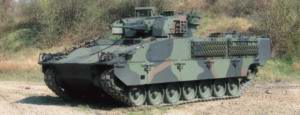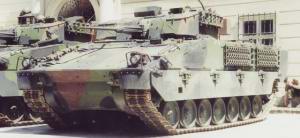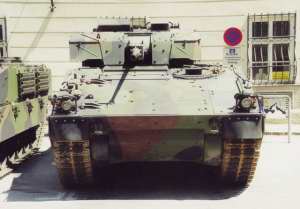| Designation: | Ulan |
 |
|---|---|---|
| Manufacturer: | ASCOD AIE | |
| Product type: | Armoured Vehicles | |
| Name: | Reconnaissance Vehicle |
In the 1980s, the Austrian company, Steyr-Daimler-Puch (which designed and built the 4K 4FA and 4K 7FA full-tracked armoured personnel carriers covered in a separate entry) started private venture studies in close co-operation with the Austrian Army for a new Armoured Infantry Combat Vehicle (AICV) which eventually became the ASCOD.
The first prototype (PT01) was completed in 1990, with the turret and chassis being built in Austria and systems integration taking place in Spain. It weighed 21 tonnes, was powered by a 500 hp Pegaso diesel and used the track of the Steyr-Daimler-Puch SK 105 light tank. The 30 mm cannon was not stabilised and no fire-control system was fitted.
This was one of the five vehicles tested in Norway and, together with the now BAE Systems Land Systems Hägglunds CV9030 and the now BAE Systems, Ground Systems (previously United Defense LP) M2 Bradley, was shortlisted by the Norwegian Army for a further series of trials.
The second prototype (PT02) was completed in late 1992 and weighed 26 tonnes. The turret was made in Austria, the chassis in Spain, with final systems integration taking place in Spain. Improvements included more powerful MTU 600 hp diesel engine, wider tracks, modified turret and redesigned troop compartment.
The third prototype (PT03) was rebuilt as a result of the original trials with PT01 in Norway and had many further improvements including an additional road wheel station either side making a total of seven. For improved cross-country mobility Horstman Defence Systems rotary dampers were fitted, as was a track tensioning system. Stowage and internal layout were also improved.
PT04 was completed in 1994 and was built in Spain; this is the baseline for the Spanish Army version and features virtually all the improvements incorporated in the earlier vehicles.
A joint-venture company was formed by Steyr-Daimler-Puch and General Dynamics Santa Bárbara Sistemas of Spain called ASCOD (Austrian Spanish Co-Operative Development) which carries out marketing of the vehicle on a worldwide basis.
The first customer for the ASCOD AIFV was the Spanish Army, which has a contract with General Dynamics Santa Bárbara Sistemas for an initial 144 Pizarro ICV, worth USD330 million.
The first batch of 144 vehicles have now been delivered to the Spanish Army and this consisted of 122 IFV and 22 command post vehicles.
General Dynamics Santa Bárbara Sistemas has been awarded a contract for the production of a second batch of Pizarro vehicles which are now due to be delivered from the second quarter of 2008 with deliveries to run through to 2013. This batch will now consist of 106 IFV, 27 observer, 10 recovery and 47 armoured engineer vehicles.
This second batch of Pizarro IFV will have many improvements including a new powerpack, enhanced night vision with second-generation thermal camera, enhanced weapon stabilisation system, new communications system, new 16-bit electronics system, optimised hull design to reduce vibration, GPS receiver and compliance with EMC regulation MIL STD 461.
In May 1999, the Austrian MoD finally awarded Steyr-Daimler-Puch Spezialfahrzeug AG & Co KG a contract worth Sch3.2 billion for the delivery of 112 Ulan Armoured Infantry Fighting Vehicles (AIFV) to the Austrian Army.
Ulan is the Austrian Army name for ASCOD (Austrian Spanish Co-operative Development) AIFV, which was developed to meet the requirements of the Austrian and Spanish armies.
Under current plans, the Austrian Army has formed three battalions which will each have two companies equipped with the new Ulan AIFV, with one remaining company equipped with the older Steyr-Daimler-Puch 4K 4FA-G2 Armoured Personnel Carrier (APC). This model is fitted with a one-person turret armed with an unstabilised Oerlikon Contraves 20 mm cannon.
The first four preproduction Ulan AIFVs were delivered to the Austrian Army in 2001 and production ran at the rate of 70 per year, with final deliveries late in 2004. These incorporated a number of improvements including new armoured skirts.
This order for 112 vehicles is however insufficient to replace all of the older 4K series vehicles currently in service with the Austrian Army. Many of the key Ulan support roles, such as command post and mortar carrier functions, will still be carried out by the older vehicles. A total of 445 of these 4K series vehicles were delivered to the Austrian Army between 1961 and 1969.
In many respects Ulan is a second-generation vehicle and it incorporates many features that were not in the original vehicles or even in the first batch of production vehicles in Spain.
The hull and turret of the ASCOD is of all-welded steel armour construction which provides, by a modular system, full protection against attack from 7.62 × 51 mm small arms fire through a full 360°. Over the frontal 60° arc, the vehicle is protected against 14.5 mm API (Armour-Piercing Incendiary) attack.
The vehicle can be fitted with additional steel armour plates to the turret front and sides, glacis plate and hull sides, which provide a higher level of protection.
Option one protects against 30 mm APDS (Armour-Piercing Discarding Sabot) projectiles fired from a range of 1,000 m over a 24° frontal arc.
Option two provides protection against 30 mm APFSDS (Armour-Piercing Fin-Stabilised Discarding Sabot) rounds fired from 1,000 m through the frontal 60° (for example 30° left and right of the vehicle centre-line). Over the remainder of the vehicle protection is provided against 14.5 mm API attack through 360°.
Against indirect fire, the ASCOD provides the crew with protection from a 155 mm HE projectile bursting 10 m from the vehicle with a 90 per cent confidence level.
Special attention was made in the design of the ASCOD to provide a high degree of protection against both anti-tank and anti-personnel mines.
The chassis and turret of the ASCOD are fitted with spall liners to further reduce the behind armour effects of a variety of battlefield weapons. According to the manufacturer, the vehicle also has a low radar and infra-red signature.
The Spanish vehicles can be fitted with additional Explosive Reactive Armour (ERA) packages, developed by General Dynamics Santa Bárbara Sistemas, to the hull and turret.
The driver is seated front left with the power pack to his right. The latter consists of the German MTU 8V-183 TE22 V90 liquid-cooled turbocharged diesel developing 600 hp at 2,300 rpm coupled to a Renk HSWL 106C hydromechanical fully automatic six-speed transmission with integrated steering system. The Austrian Ulan is powered by a more recent MTU 8V 199 TE20 8V-90 diesel engine developing 721 hp at 2,300 rpm.
The complete power pack, consisting of the engine, transmission and cooling system, can be removed from the ASCOD in about 15 minutes.
Mounted in the centre of the hull offset to the right is the two-man power-operated turret with the commander seated on the left and gunner on the right.
Main armament comprises a dual-feed Mauser 30 mm Mauser MK 30-2 with 200 (120 + 80) rounds of ready use ammunition and an additional 202 rounds in reserve. The gunner can select single shot, 3- 5- and 10-round bursts.
Natures of 30 mm ammunition that can be fired include multipurpose tracer, armour-piercing fin-stabilised discarding sabot - tracer, frangible armour-piercing discarding sabot - tracer and the new airburst munition.
The airburst munition is considered to be a major advance and can be used to defeat a variety of threats including light armoured vehicles and dismounted infantry. All natures of 30 mm ammunition have a plastic driving band which is claimed to extend barrel life by a factor of three.
A 7.62 mm MG3 machine gun is mounted coaxial to the left of the 30 mm cannon and this is provided with 700 rounds of ready use ammunition and a further 2,200 rounds in reserve. Two banks of three Wegmann 76 mm smoke/fragmentation grenade launchers are mounted either side of the turret, firing forwards.
The all-electric traverse and weapon elevation system has been developed by the now Curtiss-Wright Antiebstechnik GmbH, with controls being provided for commander and gunner.
Weapon elevation of +50° enables battlefield helicopters to be engaged and, if required, the commander can override the gunner. A deck clearance system is fitted as standard and the turret will not function while any of the hatches are open.
To engage targets under a wide range of conditions the gunner is provided with the Kollsman Direct Night Range Sight (DNRS) fire-control system, which includes a digital computer and a day/thermal night sight with integrated eye safe laser range-finder. The commander has a day sight with a monitor screen showing a picture of the target seen by the gunner.
The DNRS plus the advanced day/night sighting system and two-axis stabilised 30 mm cannon enable the ASCOD to engage a wide range of battlefield targets under all weather conditions with a high first round hit probability with the vehicle stationary or moving.
The turret is designated the SP-30 and can be fitted to other vehicles, tracked and wheeled, including the reconnaissance version of the Steyr-Daimler-Puch Pandur series of 6 × 6 and 8 × 8 vehicle. For installation on lighter vehicles, the armour protection would be to a lower level of protection.
The troop compartment is at the rear with the eight infantry being seated on individual fold-up seats, five down the left side and three down the right side. All the seats are provided with seat belts. Normal means of entry and exit for the troops is via a large power-operated door in the rear that opens to the right, which has a single vision block with a spherical firing port below.
Over the left side of the troop compartment roof is a cupola with day periscopes which allows the squad leader all-round vision before he dismounts with the troops. This cupola is also provided with a hatch cover that opens to the rear. There is an additional rectangular hatch cover in the right side of the roof, which opens to the right.
Suspension is of the torsion bar and trailing arm type with seven dual rubber-tyred road wheels either side, drive sprocket at the front, idler at the rear and three track-return rollers.
Rotary dampers are provided at the first and sixth road wheel stations and a hydraulic track tensioning system operated by the driver is fitted as standard.
The 500 mm wide Diehl Type 129C4 tracks are of the double-pin type and can be fitted with grousers for use in winter conditions, but when these are fitted maximum road speed is 40 km/h.
Standard equipment includes: fire detection/suppression system for the engine compartment; central climatisation which consists of an NBC/ventilation system with optional air conditioning and water heating system (located in the right side of the hull); passive night vision device for the driver and two bilge pumps.
A wide range of optional equipment can be installed on the vehicle including a fully automatic fire/explosion detection system for the crew compartment; preheating of the coolant; land navigation system, including Global Positioning System (GPS); and an integrated threat countermeasures system can be installed on the vehicle at the user's request. The hull and turret have been designed for the installation of the intercom and communication equipment selected by the user.
A power-operated dozer blade can be mounted at the front of the hull and operated by the driver under full armour protection. This can be quickly replaced by a mineclearing system of the roller or plough type.
According to ASCOD the vehicle has plenty of stretch potential up to a gross vehicle weight of 28 to 30 tonnes with engine upgraded.
As previously stated, the Austrian Ulan has a number of advanced features that are not fitted to the Spanish Pizarro vehicle.
For the first time in an AIFV an automatic target tracker (ATT) is installed for increased accuracy against moving targets. The ATT receives the image as viewed through the thermal sight, processes it, and controls the line of sight servo-control and gun and turret drive system to maintain the aiming reticle fully automatically on the target. The vehicle commander has a roof-mounted periscope sight plus a remote display of the gunner's thermal sight.
Ulan also has a more powerful power pack than Pizarro, which consists of an MTU 8V-199-TE 20 diesel developing 721 hp coupled to a Renk HSWL 106 hydro-mechanical six-speed transmission with integrated reverse and steering gear.
With a combat weight of 25.2 tonnes, based on the basic protection level, this gives Ulan a high power-to-weight ratio of 28 hp/tonne.
Steyr-Daimler-Puch has completed production of the Ulan for the Austrian Army but is still involved in maintenance and upgrade work on this vehicle.
In 2006 it was revealed that the company was working on an enhanced version of the vehicle called Ulan 2.
This has a number of improvements over the standard Ulan including an additional plate under the hull for improved protection against anti-tank mines, reinforced welded seams, additional internal plate plus a redistributed seat arrangement and modified internal stowage.
At this stage the MTU diesel engine of the standard Ulan is expected to be retained but the torsion bars may be upgraded to take into account the additional weight of this variant
Studies have shown that the chassis of the Ulan AIFV could be fitted with the latest version of the Russian BMP-3 turret armed with 100 mm gun, 30 mm coaxial cannon and 7.62 mm co-axial machine gun. Variants
Using the basic chassis, ASCOD has suggested that the chassis of the vehicle can be used for a wide range of other roles and be fitted with different turrets.
Late in 1998 the ASCOD was tested in the United States fitted with the General Dynamics Land Systems 105 mm armed Low-Profile Turret (LPT). This is no longer being marketed.
For trials purposes, late in 1997 one of the prototypes of the ASCOD chassis was fitted with the complete Denel Land Systems turret of the South African Rooikat 105 mm (8 × 8) armoured car. This then underwent a successful series of firing trials. This is no longer being marketed.
For trials purposes, in early 2000 an ASCOD chassis was fitted with the turret developed by Oto Melara, which is fitted to the Centauro (8 × 8) tank destroyer in service with Italy (400) and Spain (84)). This is no longer being marketed.
Various types of air defence weapons, gun and missile could be mounted on the ASCOD chassis..
This would have a raised superstructure, have a two-man crew and carry four stretchers or up to eight seated patients or a combination of stretcher and seated patients.
Various types of anti-tank weapons and/or turrets can be fitted onto the roof of the ASCOD.
This would be based on the chassis of the ASCOD but be fitted with a 3.3 m wide dozer blade which could be angled left and right.
Pivoted on the left side of the hull would be a hydraulic arm, which could be fitted with various engineer attachments including a bucket. Armament would comprise a cupola-mounted .50 (12.7 mm) M2 HB machine gun and, in addition to the two-man crew, the vehicle would also carry seven men.
This would be a flatbed-type vehicle and be able to carry a maximum load of 10 tonnes.
To provide additional space for the command staff this version would have a raised roof at the rear and be fitted with a cupola armed with a 7.62 mm MG.
In addition to being fitted with various types of turntable-mounted 81 and 120 mm mortars, the ASCOD could also be fitted with a turret-mounted 120 mm mortar system and have a four-man crew.
For trials purposes, a Ulan AIFV has been fitted with a new German REX (Renk Electric Crossdrive) hybrid drive system coupled to the existing Renk HSWL 106 mechanical transmission.
The REX concept combines the existing components of the Renk HSWL family of transmissions with electric motors and generators in a common transmission housing.
The combination of the prime mover with a high power auxiliary power system is claimed to be very fuel efficient and provides immediate power to the vehicle drive system when the requirement occurs in combat situations.
The customary torque converter is replaced by a power splitter unit with two electric motors connected to the transmission and diesel engine, providing both automotive power and electrical power generation.
To carry out the recovery/repair role this model would have a rear-mounted stabiliser blade and winch and a crane which can lift a maximum of 6,500 kg. Like the command post version, this would have a raised superstructure and be fitted with a cupola armed with a 7.62 mm machine gun. Normal crew would consist of four men.
 |
 |
 |
 |